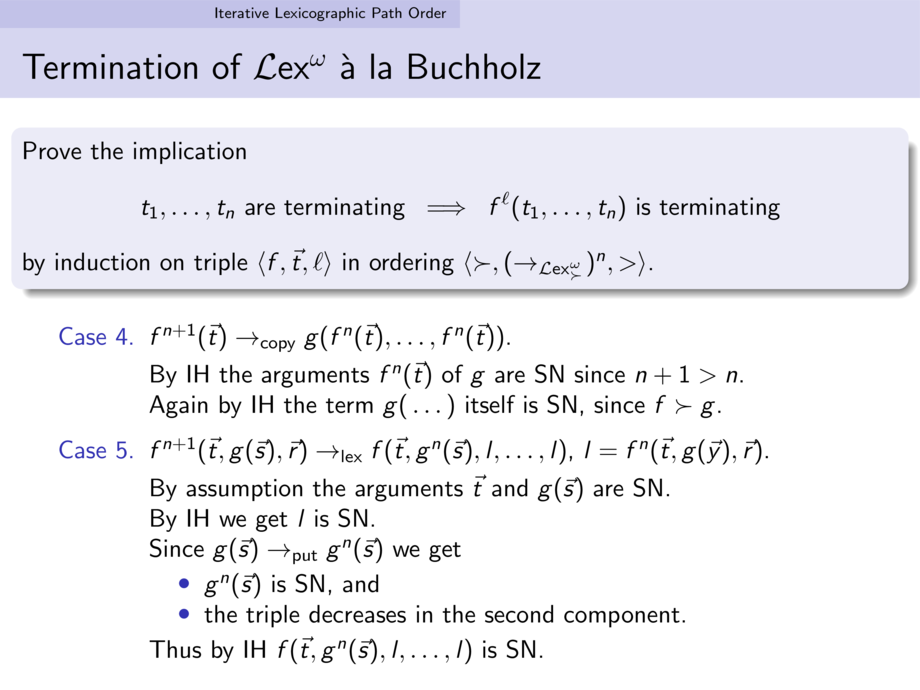



































































































343/365
\begin{frame}[t]
\frametitle{Termination of $\trsllex$ \`a la Buchholz}
\vspace{-1ex}
\begin{block}{}
Prove the implication
$$\mbox{$t_1,\ldots,t_n$ are terminating}
\;\implies\; \lsymonea{\ell}{t_1,\ldots,t_n} \text{ is terminating}$$
by induction on triple $\langle \asymone, \vec{t}, \ell\rangle$
in ordering
$\langle\arel, (\airew{\itrsllex{\arel}})^\anat, \sorngt\rangle$.
\end{block}
\medskip\pause
\begin{changemargin}{1cm}{0cm}
\begin{itemize}
\alt<1-4>{
\item [Case 1.]
Internal step $\lsymonea{\ell}{\ldots,t_i,\ldots} \to \lsymonea{\ell}{\ldots,t_i',\ldots}$.\\
\smallskip
The triple decreases in the second component.
\medskip
\pause
\item [Case 2.] $\lsymonea{}{t_1,\ldots,t_n} \myairew{\text{put}} \lsymonea{\anat}{t_1,\ldots,t_n}$.\\
\smallskip
We have a decrease in the third component.
\medskip
\pause
\item [Case 3.] $\lsymonea{\anat}{t_1,\ldots,t_n} \myairew{\text{select}} t_i$.\\
\smallskip
By assumption $t_i$ is SN.
\medskip
}{
\item [Case 4.] $\lsymonea{\anat+1}{\vec{t}} \myairew{\text{copy}} \symoneb{\lsymonea{\anat}{\vec{t}},\ldots,\lsymonea{\anat}{\vec{t}}}$.\\
\smallskip
By IH the arguments $\lsymonea{\anat}{\vec{t}}$ of $\bsymone$ are SN since $\anat + 1 > \anat$.\\
Again by IH the term $\symoneb{\ldots}$ itself is SN, since $\asymone \arel \bsymone$.
\medskip
\pause \pause \pause \pause
\item [Case 5.] $\lsymonea{\anat+1}{\vec{t},\symoneb{\vec{s}},\vec{r}}
\myairew{\text{lex}}
\symonea{\vec{t},\lsymoneb{\anat}{\vec{s}},\alhs,\ldots,\alhs}$,
$\alhs \isdefd \lsymonea{\anat}{\vec{t},\symoneb{\vec{\btrmvar}},\vec{r}}$.\\
\smallskip
By assumption the arguments $\vec{t}$ and $\symoneb{\vec{s}}$ are SN.\\
By IH we get $l$ is SN.\\
Since $\symoneb{\vec{s}} \myairew{\text{put}} \lsymoneb{\anat}{\vec{s}}$ we get
\begin{itemize}
\item $\lsymoneb{\anat}{\vec{s}}$ is SN, and
\item the triple decreases in the second component.
\end{itemize}
Thus by IH $\symonea{\vec{t},\lsymoneb{\anat}{\vec{s}},\alhs,\ldots,\alhs}$ is SN.
}
\onslide<6>{}
\end{itemize}
\end{changemargin}
\end{frame}

